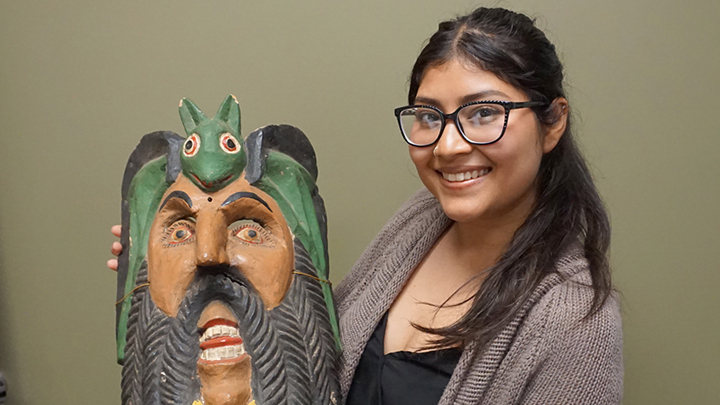Indigenous Mask Collection Showcases Artistry and History of Mesoamerica
A digitized database of more than 300 masks is hosted by the SDSU Center for Latin American Studies

Irene Gonzalez, a master’s student in Latin American Studies at San Diego State University is leading a significant project to digitize a collection of Mexican folk art mask artifacts. More than 300 items represent the rich cultural history (from the 1940s–90s) of artists from regions of Mexico such as Oaxaca, Michoacán, Guerrero, and Puebla.
The spectacular collection of Indigenous folk art masks features a diverse array of characters including tigers, serpents, owls, badgers, coati, coyote, deer, pigs, birds, devils, Spanish elite, and clownish figures. Some are painted in vibrant hues of green, red, black, or yellow adorned with natural elements such as horsehair beards, animal teeth, and sheepskin. Others feature fantastical paint reminiscent of a caricature, while some have more realistic details.
The collection is a donation from Janet Brody Esser, former SDSU Center for Latin American Studies (CLAS) associate director (1975-2003), and consists of mask regalia and other items including retablos (traditional devotional altar pieces), miniatures, and props used in theatrical plays.
Brody Esser was a renowned expert in the fields of Mexican folk art and Indigenous Mexican culture, especially those of the state of Michoacán.
In 1988, she served as the senior curator of “Behind the Mask in Mexico,” an exhibition by the Museum of International Folk Art in Santa Fe, New Mexico, funded by the National Endowment for the Humanities. She edited the illustrated catalog for the exhibition and authored several essays on mask making and the ritual use of masks by artists from Michoacán.
A closer look into Indigenous Mexican ethnography through masks
When Gonzalez began work as a graduate assistant in the CLAS office, she didn’t realize her passion for cultural heritage preservation would align so perfectly with the needs of the center and this project.
CLAS Director Ramona Pérez acquired the mask collection in 2022, and she knew Gonzalez was the perfect candidate to complete the task of researching, organizing, categorizing, and tagging all the masks and ephemera housed (in archival boxes).
“The Esser Mask Collection became Irene's project almost overnight,” Pérez said. “She had no previous experience with Mesoamerican folkart or with art collections but was mesmerized by what each mask represented in terms of the history and culture that was captured in each one.”
Gonzalez interned under Amanda Lanthorne, assistant head of special collections/university archivist, was accepted to the UCLA/Getty Museum Conservation Summer program, and recently received a grant with Keith Chan, lecturer in anthropology to create 3D images of the collection from the SDSU VITal Research Center, an incubator for nontraditional learning.
“Irene has an unrivaled commitment to the preservation of Mesoamerican Indigenous history and culture through the art of masks, and her work has made them accessible to future generations,” Pérez added.
This collection is a unique resource that allows students and the general public to study Indigenous Mexican ethnography and witness the historical artwork used in Mexican ceremonies and traditional theater productions. It provides a glimpse into how cultural connections to the past remain and have transformed over time.
The collection holds an abundance of Victoriano Salgado Morales masks. Born in 1920 in Uruapan, Michoacán, Mexico, he is considered a grand master of Mexican folk art, and is well known for skilled craftsmanship of carved wooden masks, using the Indigenous maque or laca technique. This technique involves creating protective coatings and decorative designs using a combination of materials such as the use of “aje,” the larvae of the (coccus axin) insect, from which a waxy substance is extracted and mixed with chia or linseed to create the lacquer.
His masks, used in traditional cultural festivals in Barrio de la Magdalena, Uruapan, reflect the rich heritage of the Purépecha people.
During her research, Gonzalez said she became a “connoisseur” of Salgado Morales. She grew to admire “the way he paints (using maque) — his paint is smooth and shiny, and the way he creates high cheekbones and uses animal horns and teeth in his carvings.”
One Salgado Morales mask in the collection, “Oni of Ife Mask copy,” was a commissioned piece (circa 1970) that replicated an African piece illustrated in a UNESCO book by William Fagg. Since the book only featured a frontal view, Salgado interpreted it in mask form, while the original Nigerian model is a 3D bronze head of the Oni of Ife.
Collectors place high value on these pieces. Salgado Morales’ “Mascara de Diablo con Serpiente” (“Devil Mask with Snake”) recently sold in an online auction for $900. Another devil mask used in a play is displayed in the British Museum and a version similar to it is housed in the SDSU collection.
The online database currently allows open access for all and will be expanded as the 3D images and other details become available. Researchers and students can view photos of the masks, learn essential details, and make an appointment to see the masks in person.
“The goal is to produce open education resources (OER) materials from this collection that can be used widely in curriculum, research projects, and that serves as a resource for Indigenous communities who continue to use masks in dance and other ceremonial practices,” Gonzalez said.
